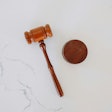
Exploding exercise balls can lead to expensive lawsuits, unless health club owners follow these important steps.
Editor's Note: While a clause in the final agreement dictates that all names and exact dollar amounts be kept confidential, this lawsuit nonetheless provides an important lesson for all athletic facilities.
My litigation practice has taken me into hundreds of athletic facilities over the last few years and I have witnessed facilities making expensive mistakes on a regular basis. Operating a sports facility carries many risks, some of which are unavoidable, but reducing or eliminating risks where possible can result in your facility avoiding lawsuits. Recently, I handled a case in which a small mistake resulted in a multimillion-dollar lawsuit against a health club.
EXPLODING EXERCISE BALL The plaintiff in this case was lifting two 40-pound dumbbells above his chest while resting his upper back on top of an exercise ball. The ball, which had been purchased from a well-known equipment manufacturer, split down the side and instantly deflated. The plaintiff tumbled to the floor, injuring his wrists and back in the process.
Although his injuries were not life-threatening and were easily treated, the plaintiff filed a lawsuit against the health club, as well as the exercise ball manufacturer and distributor, seeking more than $5 million in damages. Most lawsuits based upon these types of relatively minor injuries do not seek millions of dollars in damages, and they typically are either barred by the facility's waiver agreement or they resolve informally for reasonable amounts well under $50,000.
In this case, the plaintiff claimed to be entitled to millions of dollars because he was training to join the PGA's Champions Tour. He argued that despite never competing as a professional golfer in his life, he was on his way to earning millions in prize money and endorsements before his golf career was derailed by his injuries.
The plaintiff's plan to become a professional golfer turned this fluke accident into a two-and-a-half year litigation battle that cost the three defendants hundreds of thousands of dollars in legal fees.
THE ALLEGATIONSThe plaintiff's lawsuit asserted a litany of allegations against the various defendants, including claims that the exercise ball was not properly designed and manufactured. Since the health club was not responsible for manufacturing or designing the ball, that claim was quickly dismissed by the court, and the plaintiff was not allowed to proceed on these theories against the club. The claim that created the biggest issues for the health club alleged that it negligently maintained and inspected the exercise ball prior to the incident, thus creating the dangerous condition that caused the accident.
The specific allegations in the lawsuit included that the club failed "to conduct timely and adequate inspections of equipment for defects and potential hazards such as damage or excessive wear." These claims were based upon the instructions the manufacturer provided with the exercise ball that indicated the ball had a commercial-use life expectancy of one year. The instructions also stated the user should check "for wear on the ball" before each use and immediately discard the ball if its surface has any nicks, cuts or scratches, because such defects could weaken the ball and possibly result in the ball deflating during use.
CLUB RESPONSE All the club needed to do was demonstrate it had followed the manufacturer's recommendations and it would be dismissed from the lawsuit. Unfortunately, the club was unable to establish when the exercise ball was first put into use at the club, making it impossible to prove that it had not been in use for longer than the one-year life expectancy. Records indicated that balls had been purchased from this manufacturer both before and during the one-year period leading up to the accident, but there was no way to determine when the ball involved in the accident was purchased and placed on the gym floor.
Moreover, the club was unable to establish an inspection record for the ball. Although the personal trainers using the exercise balls with clients were trained to look over the balls before each use, there were no records to indicate when each ball was inspected, opening the door for the plaintiff to argue the ball involved could have gone weeks without being inspected for damage.
These two arguments were sufficient to convince the judge to allow the case to proceed against the health club, forcing the club's insurance carrier to spend more than $100,000 defending the lawsuit. Ultimately, a full trial was avoided due to a last-minute settlement between the parties that was closer to the standard amount than the seven figures requested by the plaintiff.
LIMITING THE RISKEvery piece of equipment in your facility comes with documents outlining the life expectancy and maintenance recommendations for the product. The best way to avoid an expensive lawsuit based upon equipment problems is to take every step necessary to ensure the accident does not happen in the first place. By paying attention to and following the guidelines provided by equipment manufacturers, and documenting each step of compliance, you can protect your facility from unnecessary accidents and, ultimately, avoid potentially costly lawsuits.
Did You Know?
Former Sacramento Kings forward Francisco Garcia and the Sacramento Kings both filed a lawsuit against exercise ball manufacturer Ledraplastic after Garcia was injured after falling to the ground when an exercise ball burst underneath him. At the time, he was balancing on the exercise ball while lifting two 90-pound weights. He fractured his right arm and missed four months of the 2009-10 NBA season. The parties settled for an undisclosed, but reportedly hefty, amount in late 2012.




































